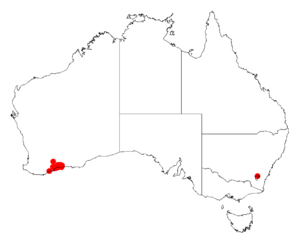Acacia phlebopetala facts for kids
Quick facts for kids Acacia phlebopetala |
|
|---|---|
| Scientific classification | |
| Genus: |
Acacia
|
| Species: |
phlebopetala
|
 |
|
| Occurrence data from AVH | |
Acacia phlebopetala is a type of shrub. It belongs to the Acacia family. This plant is special because it only grows in south-western Australia. This means it is endemic to that area.
Contents
What Does Acacia phlebopetala Look Like?
This shrub usually grows to be about 0.3 to 1.5 meters (1 to 5 feet) tall. Like many Acacia plants, it has phyllodes instead of true leaves. Phyllodes are flattened leaf stems that look and act like leaves.
The phyllodes are always green. They can be smooth (glabrous) or slightly hairy. They often look crowded on the branches. These stiff, pointed phyllodes are shaped like a triangle. They are about 5 to 10 millimeters long and 5 to 11 millimeters wide. Each phyllode has a main vein near its lower edge.
This plant blooms from September to April. It produces pretty cream-white flowers.
How Is It Classified?
Different Types of Acacia phlebopetala
Scientists group living things into categories. This helps us understand them better. Acacia phlebopetala has two main types, called variations:
- Acacia phlebopetala var. phlebopetala
- Acacia phlebopetala var. pubescens
Where Does Acacia phlebopetala Grow?
This shrub is found naturally in Western Australia. It grows in the Great Southern and Goldfields-Esperance regions. You can often find it on rocky cliffs or along watercourses. It also grows on sandy plains and coastal cliffs and dunes.
The plant prefers sandy, loamy, or clay soils. These soils are often found over or near limestone, laterite, or quartzite rocks. Its home stretches from Beaufort Inlet in the west to Munglinup in the east. Most of these plants are found in Fitzgerald River National Park. There is also a smaller group of plants between Lake King and Newdegate to the north west.

